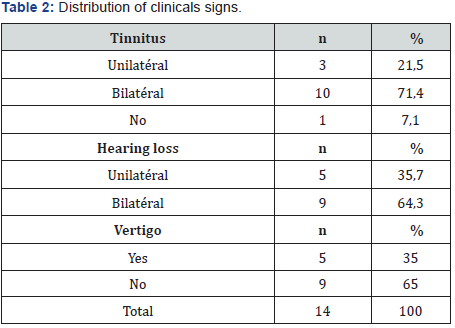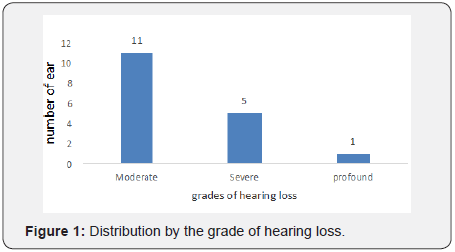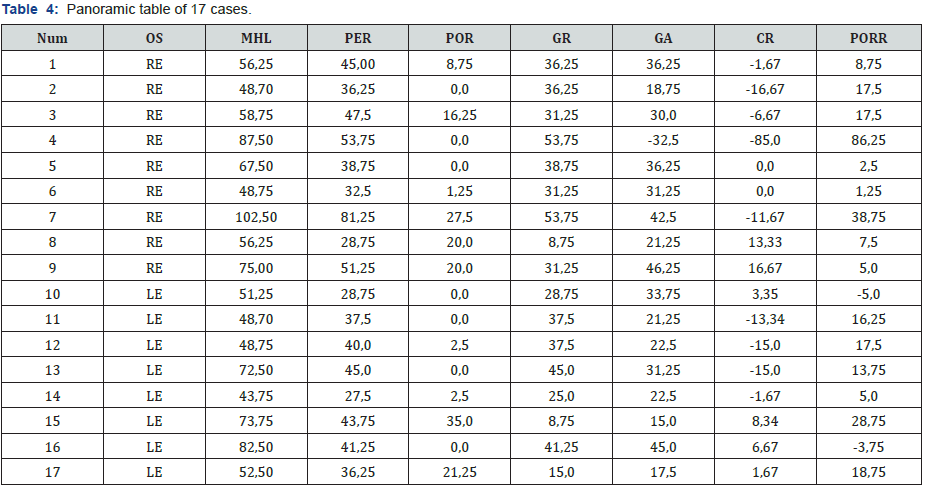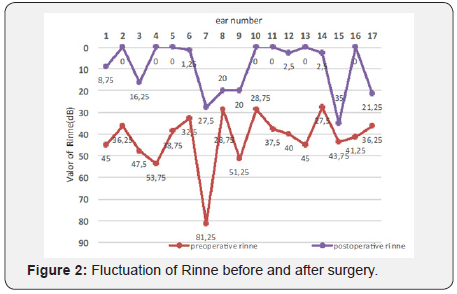Otospongiosis In Black Person: Characteristics and Postoperatives Results
C Ndiaye1*, H Ahmed1, A Kishabaga1, A Tall1, E S Diom2, S Maiga1, M W Barry1, N Pilor1, A Mbaye1, N Ndour1, I C Ndiaye1, G Wanna3 and P Claros4
1ENT department of FANN teaching hospital, Senegal
2ENT department of Diamnadio’s children hospital, Senegal
3Otoneurology department of Roger salengro hospital, France
4Clinica Claros, Barcelona
Submission: September 20, 2019; Published: October 23, 2019
*Corresponding author: Dr Ciré Ndiaye, ENT department of FANN teaching hospital, Dakar, Sénégal
How to cite this article: C Ndiaye, H Ahmed, A Kishabaga, A Tall, E S Diom. Otospongiosis In Black Person: Characteristics and Postoperatives Results. Glob J Oto, 2019; 21(1): 556052. DOI: 10.19080/GJO.2019.20.556052
Abstract
Introduction: Otosclerosis is estimated between 0.3 and 0.4% in Caucasians, this rate is lower in Japanese, Chinese, Indonesian, while otospongiosis is extremely rare in black. There are very few studies on otospongiosis in black. The aim of this work was to study the clinical features and evaluate the postoperative results of otosclerosis in black.
Patients and Methods: This was a retrospective study, performed at the ENT department of the FANN University Hospital Center, concerning cases of otosclerosis surgery collected between January 2000 and January 2014. The analysis of the functional results was performed on pre- and postoperative tonal audiometric data using :
a. The recommendations of the American Academy of Otolaryngology - Head and Neck Surgery (AAO-HNS)
b. The classification established by the International Bureau of Audiophonology (BIAP).
Results
i. 14 patients had been selected, 11 had operated on one ear and 3 on both ears, making a total of 17 operated ears.
ii. The mean age at the time of surgery was 34.57 years. The male subjects were 3 to 11 females with a sex ratio of 0.27.
iii. The average duration of symptomatology was 5 years with extremes of 1 and 10 years.
iv. The family history of deafness was found in 3 patients (21%) of patients.
v. The mean postoperative Rinne ranged from 0 to 35dB with an average of 9.11dB. The average Rinne gain ranged from 8.75 to 53.75dB with an average of 32.94dB.
Conclusion: The hospital prevalence of shows that otosclerosis is a rare disease in black. The postoperative functional results seem better because of the important preoperative Rinne related to the delay of the diagnosis.
Keywords: Otosclerosis; Otospongiosis; Hearing loss; Black; Deafness
Introduction
Otosclerosis is an osteodystrophy of the otic capsule resulting in ankylosis of the stapes on the vestibular window, which is responsible, when it manifests clinically, for conductive hearing loss (or mixed hearing loss) [1]. Its prevalence is estimated between 0.3 and 0.4% in Caucasians, this rate is lower in Japanese, Chinese, Indonesian, while otospongiosis is extremely rare in black [2-4]. There are very few studies on otospongiosis in black. The aim of this work was to study the clinical features and evaluate the postoperative results of otosclerosis in black.
Patients and Methods
This was a retrospective study, performed at the ENT department of the FANN University Hospital Center, concerning cases of otosclerosis surgery collected between January 2000 and January 2014.
Inclusion Criteria
Included in this study the patients:
a. whose diagnosis of otosclerosis was confirmed intraoperatively,
b. having performed preoperative tonal audiometry and at least one tonal audiometry during the first postoperative year
The analysis of the functional results was performed on preand postoperative tonal audiometric data. Two recommendations were used:
1. The recommendations of the American Academy of Otolaryngology - Head and Neck Surgery (AAO-HNS) [5] were selected for this evaluation; except for the data of the frequency 3000 Hz which has been replaced by the data at 4000 Hz [6].
The functional results were expressed by calculating:
a. Mean hearing loss: Addition of thresholds in preoperative air conduction on frequencies 500,1000, 2000 and 4000 Hz divided by 4.
b. Preoperative Rinne (PER): the difference between the average preoperative air conduction (AC) and bone conduction (BC) thresholds at the 500, 1000 and 2000 Hz frequencies,
c. The postoperative Rinne (POR): difference between the average of the post-operative thresholds in air conduction (AC) and bone conduction (BC) on the frequencies 500, 1000 and 2000 Hz.
i. if POR between 0-10dB = success
ii. if POR between 11-20dB = Good result
iii. if POR between 21-30dB = Bad result
iv. if POR> 30dB = Transmission failure.
d. The gain in air conduction: preoperative AC - postoperative AC on the frequencies 500, 1000, 2000 and 4000 Hz.
e. Gain in Rinne: preoperative Rinne - Postoperative Rinne
f. Postoperative Residual Rinne (PORR): the difference between the average postoperative air conduction (AC) thresholds and the preoperative bone conduction (BC) thresholds at the 500, 1000 and 2000 Hz frequencies.
a) PORR≤10dB = closure of Rinne (Success)
b) 10 < PORR ≤20dB = good result
c) PORR> 20dB = Failed.
g. The cochlear reserve (CR), It corresponds to the gain in bone conduction: it is the difference between the average thresholds in BC on the frequencies 1000,2000 and 4000 Hz in pre and postoperative. A positive value of the cochlear reserve corresponds to an improvement of the BC, a negative value corresponds to a decrease of the BC or labyrinthization, which one considers as significant if this value is greater than 10 db.
2. The classification established by the International Bureau of Audio phonology (BIAP) [7]
Results
14 patients had been selected, 11 had operated on one ear and 3 on both ears, making a total of 17 operated ears.
Clinical Data
Age
The mean age at the time of surgery was 34.57 years (Table 1).

Sex
The male subjects were 3 to 11 females with a sex ratio of 0.27. The Table 2 reports the distribution of functional signs.

Other Signs
The other signs were: Headache in one case (7.1%), Otalgia in one case (7.1%), and peripheral facial paralysis in one case (7.1%).
Duration of Symptomatology
The average duration of symptomatology was 5 years (standard deviation of 3 years) with extremes of 1 and 10 years.
Family History of Deafness
The family history of deafness was found in 3 patients (21%) of patients.
Paraclinic Data
Temporal Bone Ct Scan
CT scan were performed in six patients (42.9%), showed otosclerosis in four patients (66.7%) and were normal in two patients (33.3%).
Preoperative Tonal Audiometry
All patients had preoperative tonal audiometry. Preoperative tone audiometry results:
i. Preoperative audiometry found conductive hearing loss in 11 ears and mixed hearing loss in 6 ears.
ii. According to the classification of BIAP: Most patients had moderate deafness (11 ears or 65%). (Figure 1)

Therapeutic Data
Eleven patients had surgery on one ear, and three patients on two ears, making a total of 17 operated ears. For patients who had surgery on two ears, the interval between the two procedures was one year.
Local anesthesia was used in 10 procedures (58.1%) and general anesthesia in 7 procedures (41.1%).
i. The transcanal approach was used in all patients (17 ears).
ii. The platinotomy was done in 16 procedures (94.1%) and total platinectomy in one intervention (5.9%).
iii. The prosthesis used in all patients was a Teflon®.
Post-Operative Complications

Table 3 summarizes the identified complications. The average duration of hospitalization was 2 days with extremes of 1 and 7 days
Post-Operative Hearing Functional Results
The auditory functional results are shown in Table 4

In deciBels (dB); Num : Numéro de patient ; LE : leght ear ; RE : right ear ; OS : operated side ; MHL : Preoperative mean hearing loss; PER : preoperative Rinne; POR : postoperative rinne ; GR : Gain in Rinne ; GA : Gain in air conduction ; CR : cochlear reserve ; RRPO : postoperative residual Rinne
i. Preoperative Rinne average: The average preoperative Rinne ranged from 27.5 to 81.5dB with an average of 42.05dB, 82.35% of patients had an average preoperative Rinne > 30dB (Figure 2)
ii. Post-operative Rinne average: The mean postoperative Rinne ranged from 0 to 35dB with an average of 9.11dB. The average Rinne gain ranged from 8.75 to 53.75dB with an average of 32.94dB (Figure 2)

Discussion
Epidemiological Aspects
The mean age at the time of surgery was 34-57 years. It varies between 15 and 35 years depending on the studies. Nemati et al in Iran found an average age of 36-45 years [8]. The clear predominance of women, from 57 to 79%, reported in the literature is also found in our series [1,9]. Women represented 79% in our study. This female predominance is explained by the existence of a hormonal factor which is an initiating or aggravating factor in the history of the disease [10-12]
Clinical Aspects
Hearing loss was the main reason for consultation, it was found in all patients. This is same finding with data from the literature [1,8,9,13-16]. Bilateral otosclerosis is also found in our study, 64.3% of patients suffered to two ears. Tinnitus was found in 92.9% of cases. Sobrinho et al. [17] in Brazil, in a series of 48 ears found 91.6% of tinnitus. Cordoves et al. [13] in a series of 47 cases in Cuba and Marrakchi et al. [15] in Tunisia in a series of 59 cases recovered respectively 89.4 and 87% of tinnitus. The occurrence of tinnitus is explained in most cases by an advanced state of the disease.
Vertigo was found in 35% of patients. Lescanne et al. [18] In France in a series of otosclerosis and Bouaity et al. [14] in Morocco found respectively 10 and 17%. There is an important genetic’s part in the genesis of otosclerosis [10-12]. In the literature family history of otospongiosis is found in 11 to 52% of cases [13,14,19]. In this study, 21% of our patients had a history of family deafness, but we could not confirm if it was a case of otosclerosis [20].
Post-Operative Hearing Functional Results
The mean audiometric Rinne had increased from 42.05dB before the operation to 9.11dB after surgery whether an average gain of 39.94dB in Rinne. This gain the highest compared to the literature (Table 5). This could be explained by our very high average preoperative Rinne, related to the delay of diagnosis. The diagnosis is made at an advanced stage of deafness, 5 years after the beginning of hearing discomfort. The postoperative Rinne was ≤20dB in 82.3% of cases. This success rate is like that reported by RIOS [25] in Spain, MAHAFZA in Jordan [10], and SOUZA in Brazil [26] who found a POR ≤20 dB in 84.21%, 85.6% and 95.1% of cases. The functional hearing results in black are like those of the literature and are generally satisfactory.

Conclusion
The hospital prevalence of shows that otosclerosis is a rare disease in black. The postoperative functional results seem better because of the important preoperative Rinne related to the delay of the diagnosis.
References
- Amor MB, Romdhane N, Khelifa Z, O Ben Gamra, S Zribi et al. (2013) Otospongiose : à propos de 149 cas. J Tun ORL 29: 36-39.
- Tshifularo MI, Joseph CA (2005) Otosclerosis among South African indigenous blacks. East Afr Med J 82(5): 223-225.
- Altman F, Glasgold A, McDuh JP (1967) The incidence of otosclerosis as related to race and sex. Ann Otol Rhinol Laryngol; 76: 377-392.
- Guild SR (1944) Histological otosclerosis. Ann Otol Rhinol Laryngol 53: 246-266.
- Monsell M, Balkany TA, Gates GA et al. (1995) Committee on Hearing and Equilibrium guidelines for the evaluation of results of treatment of conductive hearing loss. Otolaryngol Head Neck Surg 113: 186-117
- Goldenberg RA, Berliner KI (1995) Reporting operative hearing results: does choice of outcome measure make a difference? Am J Otol 16(2): 128-35.
- Recommandations du Bureau International d'Audio Phonologie (BIAP). Classification audiométrique des déficiences auditives. Annexe de la recommandation BIAP, Portugal.
- Nemati S, Naghavi E, Kaemnejad E et al. (2013) Middle ear exploration results in suspected otosclerosis cases: Are ossicular and footplate area anomalies rare? Iran J Otorhinolaryngol 25(3): 155-159.
- Mahafza T, Al layla A, Tawalbeh M, Yagoub Abu-yagoub, Ahmad Atwan Sulaiman et al. (2013) Surgical treatment of otosclerosis: Eight years’ experience at the Jordan University Hospital. Iran J Otorhinolaryngol 25(4): 233-238.
- Thomas JP, Minovi A, Dazert S (2011) Current aspects of etiology, diagnosis and therapy of otosclerosis. Otolaryngol Pol 65 (3): 162-170.
- Rudic M, Keogh I, Wagner R, Wilkinson E, Kiros N et al. (2015) The pathophysiology of otosclerosis: Review of current research. Hear Res 330: 1-6.
- Uppal S, Bajaj Y, Rustom I, Coatesworth AP (2009) Otosclerosis 1: the aetiopathogenesis of otosclerosis. Int J Clin Pract 63: 1526– 30.
- Cordovés AP, Montero EL, De Hombre AMG et al. (2007) Ear surgery outcomes in patients operated on for otosclerosis. Acta Otorrinolaringol Esp 58(3): 79-82.
- Bouaity B, Chihani M, Touati M et al. (2014) L’otospongiose: étude rétrospective à propos de 36 cas. Pan Afr Med J 18: 242.
- Marrakchi J, Bechraoui J, Meherzi S et al. (2014) L’otospongiose évolué Ann Otolaryngol Chir Cervicofac 131(4): A145
- Kolo ES, Ramalingam R (2013) Hearing results in adults after stapedotomy. Niger Med J 54(4): 236–239.
- Sobrinho PG, Oliveira CA, Venosa AR (2004) Long-term follow-up of tinnitus in patients with otosclerosis after stapes surgery. Int Tinnitus J 10(2): 197-201.
- Lescanne E, Robier A, Soin C et al. (1999) Chirurgie de l’otospongiose à propos de 227 cas Introduction de la platinotomie Laser CO2. Ann Otolaryngol Chir Cervicofac 116: 28-36.
- Granier I, Escude B, Poirrier V et al. (2009) Imagerie de l’otospongiose. EMC, Oto-rhino-laryngologie 20-047-A-60.
- Thys M, Van Camp G (2009) Genetics of otosclerosis. Otol Neurotol 30: 1021-1032.
- De Ataide AL, Bichinho GL, Patruni TM (2013) Audiometric evaluation after stapedotomy with Fisch titanium prosthesis. Bras J Otorhinolaryngol 79(3): 325-35.
- Ramsay H, Karkkainen J, Palva T (1997) Success in surgery for otosclerosis: Hearing improvement and other indicators. Am J Otolaryngol 18(1): 23-28.
- Saki N, Nikakhlagh S, Hekmatshoar M et al. (2011) Evaluation of hearing results in otosclerotic patients after stapedectomy. Iran J Otorhinolaryngol 23: 127-132.
- Garcia iza L, Navarro JJ, Goiburu M, et al. (2016) Study of the improvement in bone conduction threshold after stapedectomy. Acta Otorrinolaringol Esp 67(5): 268-274.
- Ríos APC, Campos GE, Urbieta JII et al. (2005) Stapedectomy: our results. Acta Otorrinolaringol Esp 56: 400-402.
- Souza JCR, Bento RF, Pereira LV et al. (2016) Evaluation of functional outcomes after stapes surgery in patients with clinical otosclerosis in a teaching institution. Int Arch Otorhinolaryngol 20: 39–42.





























